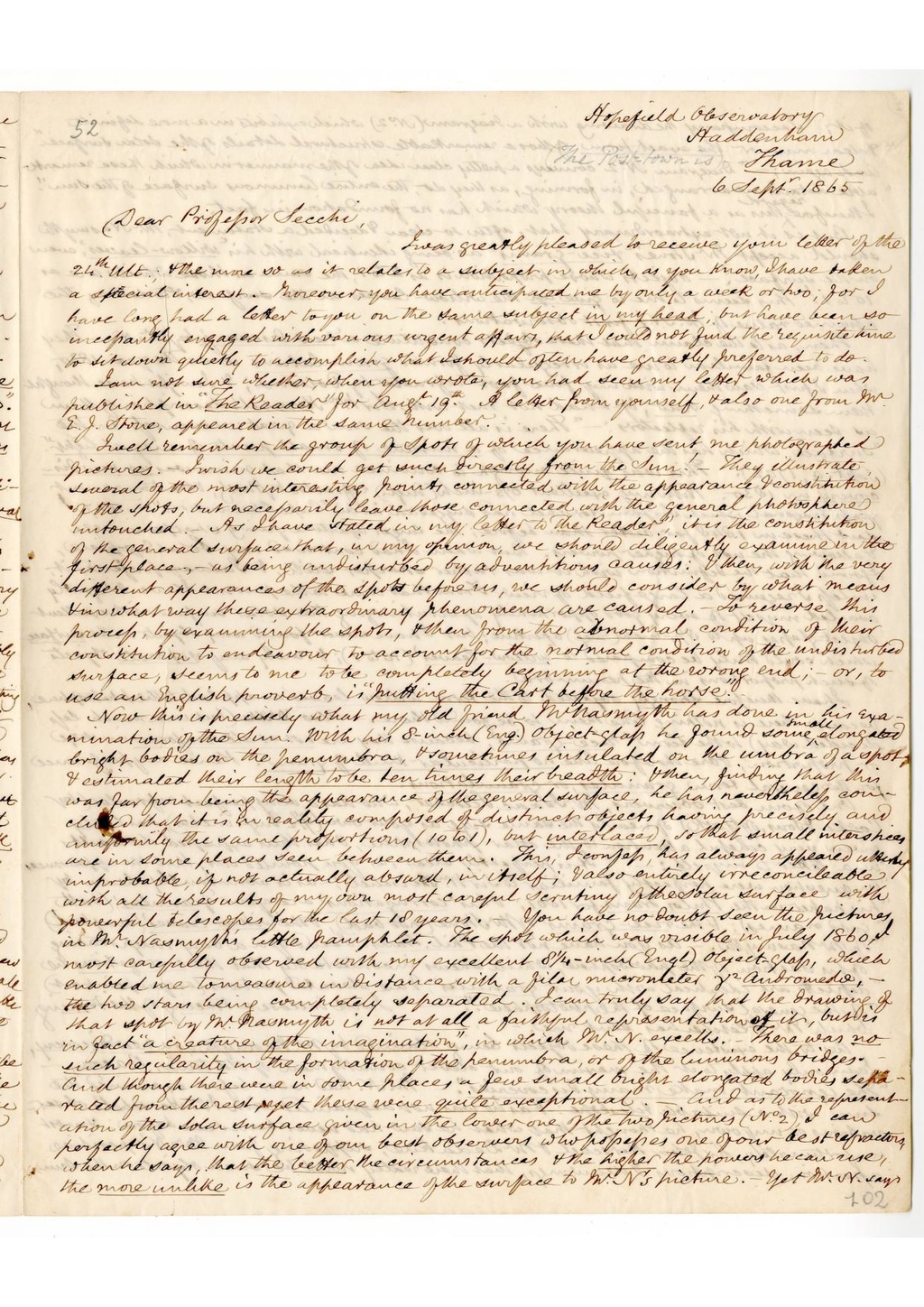Hopefield Observatory
Haddenham
Thame
6 Septr. 1865
Dear Professor Secchi,
I was greatly pleased to receive your letter of the 24th Ult.; and the moreso as it relates to a subject in which, as you know, I have taken a special interest. - Moreover, you have anticipated me by only a week or two; for I have long had a letter to you on the same subject in my head, but have been so incessantly engaged with various urgent affairs, that I could not find the requisite time to sit down quietly to accomplish what I should often have greatly preferred to do.
I am not sure whether, when you wrote, you had seen my letter which was published in "The Reader" for Aug. 19th. A letter from yourself, and also one from Mr. E.J. Stone, appeared in the same number.
I well remember the group of spots of which you have sent me photographed pictures. I wish we could get such directly from the Sun! - They illustrate several of the most interesting points connected with the appearance and constitution of the spots, but necessarily leave those connected with the general photos were untouched. As I have stated in my letter to "The Reader", it is the constitution of the general surface that, in my opinion, we should diligently examine in the first place, - as being undisturbed by adventitious causes: and then, with the very different appearances of the spots before us, we should consider by what means and in what way these extraordinary phenomena are caused. - To reverse this process, by examining the spots, and then from the abnormal condition of their constitution to endeavour to account for the normal condition of the undisturbed surface, seems to me to be completely beginning at the wrong end; - or, to use an English proverb, is "putting the Cart before the horse."
Now this is precisely what my old friend Mr. Nasmyth has done in his examination of the Sun. With his 8-inch (Eng.) object-glass he found some small elongated bright bodies on the penumbra, and sometimes insulated on the umbra of a spot, and estimated their length to be ten times their breadth: and then, finding that this was far from being the appearance of the general surface, he has nevertheless concluded that it is in reality composed of distinct objects having precisely and uniformly the same proportions (10 to 1), but interlaced, so that small interstices are in some places seen between them. This, I confess, has always appeared utterly improbably, if not actually absurd, in itself; and also entirely irreconcileable with all the results of my own most careful scrutiny of the solar surface with powerful telescopes for the last 18 years. - You have no doubt seen the pictures in Mr. Nasmyth's little pamphlet. The spot which was visible in July 1860, I most carefully observed with my excellent 8¼-inch(Engl.) object-glass, which enabled me to measure in distance with a filar micrometer γ2 Andromeda, - the two stars being completely separated. I can truly say that the drawing of that spot by Mr. Nasmyth is not at all a faithful representation of it, but is in fact "a creature of the imagination", in which Mr. N. excells. - There was no such regularity in the formation of the penumbra, or of the luminous bridges. - And though there were in some places a few small bright elongated bodies separated from the rest, yet these were quite exceptional. - And as to the representation of the solar surface given in the lower one of the two pictures (№2), I can perfectly agree with one of our best observers who possesses one of our best refractors, when he says, that the better the circumstances and the higher the powers he can use,the more unlike is the appearance of the surface to Mr. N's picture. - Yet Mr. N. says
